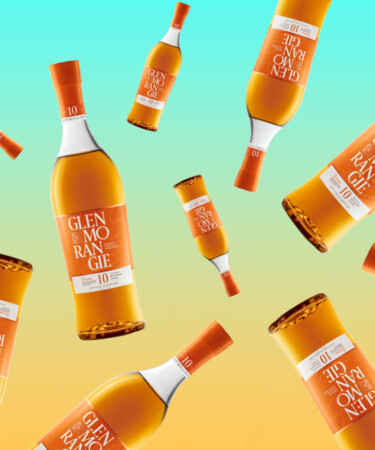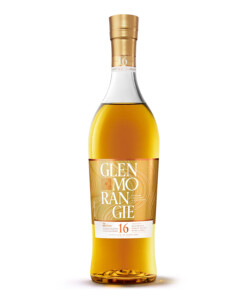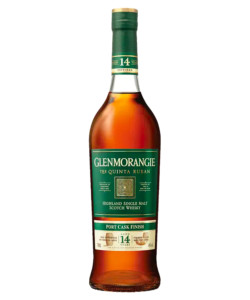Among the many distilleries in Scotland, few are more historic than Glenmorangie. In fact, legends say that the original location has been making Scotch since 1703, the earliest record of alcohol production. However, like most of the land during that time, the location was largely used for farming and agricultural purposes. That is, until 1843, when former distillery manager William Matheson acquired the Morangie Farm and converted it into the distillery we know today as Glenmorangie. From that year on, the Glenmorangie distillery has produced quality Scotch using ingredients entirely from the land it sits on.
The years that followed brought big changes for Glenmorangie and as the brand exchanged ownership, it began to embrace a newer, younger audience as well. But one thing has remained the same since those early days of the 18th century: the methods and flavors first developed by Matheson. With over 150 years of production, Glenmorangie has managed to meet drinkers exactly where they are on their Scotch journey, be it novel, explorative, or traditional. Now that we’ve scratched the surface of this legacy brand, read on for nine more things to know about Glenmorangie.
The Glenmorangie logo has an ancient story.
Back in the 8th century, a civilization named the Picts ruled over Scotland’s northeastern lands, including a peninsula that would become the home of Glenmorangie. Named for their landscape paintings and body art, the Picts carved their story into an intricate tablet known as the Hilton of Cadboll stone. In time, Glenmorangie’s distillery was built, but the Picts’ story would not be lost. To honor the civilization that first inhabited the land and cultivated the barley fields its distillery now occupies, Glenmorangie crafted a logo inspired by the swirls engraved into the ancient stone. Today, the stone resides in the National Museum of Scotland but the history of the Picts lives on through Glenmorangie’s logo.
The Glenmorangie crew is legendary beyond whisky.
Named after the distillery’s home city, Tain, the men of Tain are paramount to Glenmorangie’s production. The small group is composed of 16 craftsmen, each having the particular knowledge and skill sets to produce the beloved Scotch as it has been since 1843. Though the faces rotate throughout the years, the men of Tain remain the gatekeepers of Glenmorangie’s malt. But their fame also extends to the music industry. Inspired by their dedication, English guitarist Allan Holdsworth released an album titled “The Sixteen Men of Tain” to honor the skillful craftsmen at the helm of Glenmorangie.
Glenmorangie’s distillery is one-of-a-kind.
Of the many distilleries in Scotland, Glenmorangie surpasses the competition — in terms of height, that is. With the tallest stills in the country, the distilling equipment at Glenmorangie is the same height as an adult giraffe and the key to the Scotch’s signature flavor. According to a Lifestyle Asia interview with the brand’s head of maturing whisky stocks, the large copper stills remove elements of sulfur to allow the more delicate fruit flavors to come through in the final spirit.
Glenmorangie had to fight for its name
The Glenmorangie name comes from the Gaelic words gleann mor na sith and translates to “glen of tranquility.” Fittingly, the phrase was also used as the brand’s promotion slogan for several years. But in 2003, the company was hit with a formal complaint by an anonymous individual from Midlothian claiming that it was misrepresenting the language. The unidentified subject claimed that the true meaning of Glenmorangie loosely translated to “a big valley with a meadow of water.” Not to be budged, Glenmorangie refuted the claim and stated that the translation of Glenmorangie depended on the perceived root of the word. In the end, the brand was awarded the right to claim “glen of tranquility,” though it has since moved on to newer marketing approaches.
Get to know Glenmorangie’s signature spirit animal.
Philanthropy for a vulnerable species may not be the first thing that comes to mind when thinking of Scotch whisky, but for Glenmorangie, the giraffe has a special significance. The long-necked mammal has been described as the distillery’s spirit animal thanks to its extraordinary height, which is comparable to that of Glenmorangie’s copper stills. To ensure its beloved giraffes are protected, Glenmorangie began a conservation partnership with the Giraffe Conservation Foundation and the Royal Zoological Society of Scotland in 2020. Soon after, Glenmorangie released the Giftable Giraffe Tin, a metal container that features a giraffe print and sustainably holds any of the brand’s three expressions.
Glenmorangie recently became part of the LVMH family.
When Glenmorangie’s original owners announced they would be selling their leading shares in the company, a battle for ownership began. With alcohol conglomerates Pernod Ricard and LVMH as the front runners, there was a lot of interest as to who would take control of the world-famous Scotch brand. But in 2004, LVMH bested the competition and with a bid of 300 million pounds ($362 million) became the newest owner of Glenmorangie.
Glenmorangie is forging a new chapter.
In 2021, LVMH unveiled The Lighthouse, a new distillery made just for Glenmorangie. The exquisitely designed glass building, located on the same grounds as the original distillery, is considerably smaller and holds just two of the brand’s massive stills. Due to its size and the sensory tasting lab that sits just above it, it’s clear that the new building is meant predominantly for experimentation and innovation rather than general production.
Out with the old and in with the new.
Following its acquisition by LVMH, Glenmorangie underwent a complete makeover to align with the luxury company’s other brands. In 2007, Glenmorangie debuted its new look, featuring a curvy bottle, fresh typeface logo, and design-forward marketing campaigns to draw in a more premium audience.
There’s a Glenmorangie for every generation.
With origins dating back to the 18th century, there’s no denying the longevity of Glenmorangie. But as times and tastes have changed, the company has continued to expand its reach. Rather than marketing only to Scotch’s traditional target audience — older men — the brand in 2021 released X by Glenmorangie, a bottling targeted to clubs and Gen Z drinkers, and made specifically for mixing into cocktails. Though the full Glenmorangie portfolio holds plenty of traditional Scotches, the legacy brand continues to stay abreast of trends.


